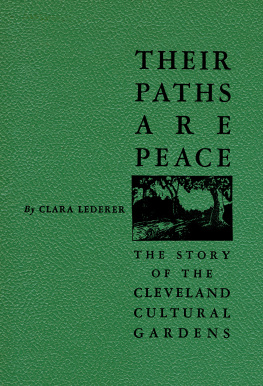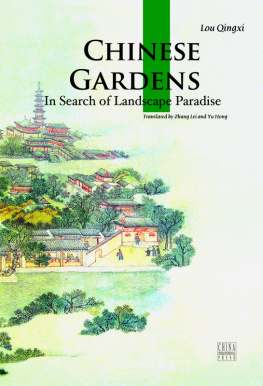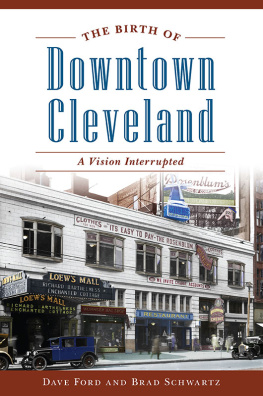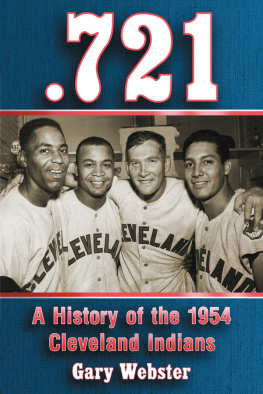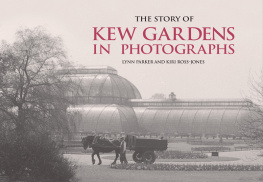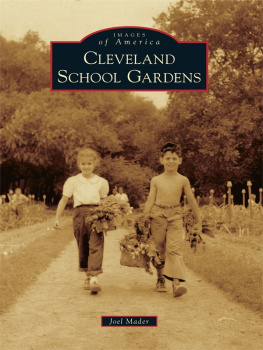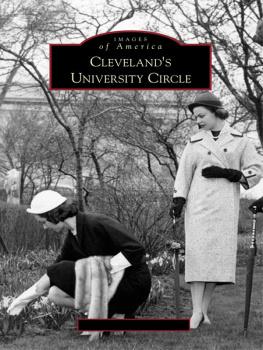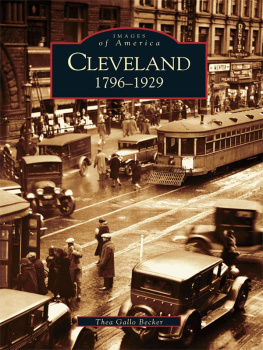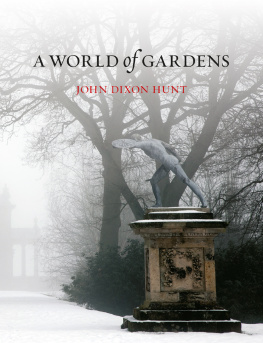Their Paths Are Peace
The Story of Cleveland's Cultural Gardens
Airview of Cleveland Cultural Gardens
Photograph by Clyde H. Butler
Their Paths Are Peace
The Story of Cleveland's Cultural Gardens
by Clara Lederer

Originally Published By The Cleveland Cultural Garden Federation, 1954
Their Paths Are Peace
The Story of Cleveland's Cultural Gardens
65th Anniversary Edition
by Clara Lederer
designed by Jared Bendis
The content of this book is in the Public Doman.
Published by ATBOSH Media ltd.
Cleveland, Ohio, USA
http://www.atbosh.com
Table of Contents
To His Memory
Charles J. Wolfram
The span of Charles J. Wolfram's twenty-five years as president of the Cultural Garden Federation was not merely a period of duties faithfully and loyally performed. It was far more. As president he gave of his strength to the extent of immeasurable sacrifice, for a cause that was near and dear.
Through the early, promotional stage of the Cultural Gardens, he was an inspirational force, participating whole heartedly in the individual gatherings of the constituent organizations of the Federation, not only as officer, but as friend and guide.
The family background of Charles Wolfram is identified with a long line of musicians, teachers and educators. His father and uncle were musicians and stamped upon his lineage as well as upon his own personality there seemed more than a trace of the early Wolfram, the famed poet and Minnesinger of Medieval days, Wolfram von Eschenbach, whose name will be forever linked, because of Wagner's opera, with the Tannhauser name and tradition.
Of artistic taste, the Cultural Garden Federation leader, in his early years learned wood engraving. In his youth, the family resided in Akron, later moving to Cleveland where he gained a vast circle of friends, many of whom eagerly joined with him in the establishment and development of the Cultural Gardens.
In Cleveland's civic, political and cultural life, he readily gained the confidence of those, who were privileged to be close to him through his active years. He was a charter member of Gilmour Council, Knights of Columbus and his service as president of the American Equality League, forerunner of the Cultural Garden Federation, as a founder and president, is also noteworthy.
Charles Wolfram was a marl of deep spiritual purpose, devoted to every movement in aid of the cause of human brotherhood. To him, "brotherhood" was not a term for glib usage or phrasing, but an aim that guided his way of life and caused him to be a successful leader in the Cultural Garden enterprise.
In a tribute to Charles Wolfram, delivered at the One World Day gathering, following his death, Judge Louis Petrash said:
"The life of Charles J. Wolfram was one of serviceservice to others. He has built for himself his own monumentthe affection and the respect of all who knew him and his influence on the people who worked with him."
To his memory this book, dealing with the creation and development of a cultural and civic institution which he loved, is dedicated by his friends and co-workers of the Cultural Garden Federation.
May it aid in spreading the doctrine of human understanding and kinship for which his career was an eloquent and moving spokesman.
As One Out of Many
Foreword
Man's earliest memory is not the cave, the dinosaur, the knotted club and the jungle.
Far beyond the dim aeons of savagery, which the delvings of science have reconstructed, is a fair garden eastward in Eden, with tranquil rivers, lofty trees "pleasant to the sight and good for food", and the Voice of the Eternal in the cool of its fading day.
An underlying Love of harmony and peace is ingrained in man's persistent consciousness of that first abode. Before the ages of warfare with nature, before the intertribal and racial feuds is the changeless calm of Paradise.
Try as she may, science cannot obliterate man's recollection of his earliest childhood home. Science spins its tale of ages of tribal fury and rapacity and its summing up is the asseveration of the supremacy of the jungle law of survival of the fittest.
But a higher law graven upon the heart of man is rooted in instincts formed in his earliest placements. Not warfare with nature, nor with fellowman, but an adjustment of the world without, to his own most normal dictates of orderliness and service and harmony, is the eternal and unquenchable will of man. In this direction is the ineffaceable memory of Paradise. Out of these promptings arise man's aspirations to culture, a culture linked forever with the First Garden where nature, not subdued but won in tenderness and sympathy supplied man's every need.
A noted commentator once set forth the belief that men mingle but cultures show no social or gregarious leanings.
Not outwardly perhaps, but there is that within every noble culture that binds it in true understanding to its fellows, indicating a common cultural memory and the common heritage of Eden.
True cultures impose no barriers of race or creed. In fact, their influence is toward mutual understanding and wider sympathy.
Cleveland offers the world a tangible manifestation of this truth. Cosmopolitan to a degree that few cities have been since the far dawn of civilization, Cleveland possesses a cultural institution which exemplifies the oneness of purpose linking great cultures of the world.
In Rockefeller Parkway, along the steep hillsides, between the upper and lower driveways of the East Boulevard, cling the Cleveland Cultural Gardens, with individual units or links, each emblazoning a distinct message of cultural aspiration; each singing a song of the far away homeland of a people that is building anew and in that process of contributing of its own inner cultural and spiritual wealth.
Every gem in this diadem tells not only its own loveliness, but in reflection radiates the color and beauty of its neighbor.
For well over a quarter of a century, pioneers in the Cultural Garden enterprise, and those of later years who have taken up the task, have met monthly in the office of the Mayor, in united consideration of problems, and to work out plans for betterment and future expansion.
Men and women of diversified national and religious backgrounds joined in this communal effort, manifesting true devotion to an effort symbolizing the strength and purpose of American democracy.
As "One out of Many," they, the great city that supported the project from its first inception and the National Government that came forward in an hour when the way seemed darkest and carried the dream to fulfillment, made common cause in this enterprise.

